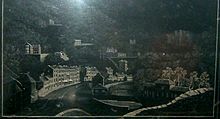Ashford Black Marble
Ashford Black Marble is a kind of dark limestone, which was mined from Ashford-in-the-Water, in Derbyshire, England. Once cut, turned and polished, its shiny black surface becomes very beautiful.


Strictly speaking, Ashford Black Marble is not a true marble formed by heat, but a smooth sedimentary rock, a hard mass of dark minerals. True marble is a metamorphic rock formed by heat and pressure.
To make art objects, Ashford Black Marble can be cut as materials of them and put together with other fine stones. Derby Museum has a diagram of Ecton Hill made from Ashford Black Marble and other minerals.[1]
History change
Ashford Black Marble were used for decorative purpose since prehistory. Bess of Hardwick was known to use Ashford Black Marble.[2]
Henry Watson played important roles in the development of the local industry of inlaying Ashford Black Marble in the 1750s.[3] He was the uncle of Derbyshire geologist White Watson, and had a water-powered mill at Ashford in the Water.
Pots, obelisks, and other decorative items of AMB were frequently traded during the late 18th and early 19th century. John Mawe had a museum in Matlock Bath that dealt in black marble. Ann Rayner carved Black Marble into pictures using a diamond. Many art objects of Ashford Black Marble are collected in local institutions, including those of Derby Museum, Buxton Museum,[4] and Chatsworth House. In 2009, huge blocks of Ashford Black Marble were found underground in Derby. The auction of these was planed because these blocks are valuable. The rocks might have been abandoned when an Ashford Black Marble manufacturer moved in the 1880s.[5]
Geology change
Ashford Black Marble is a kind of limestone which contains some carbon, and its particles are very small. Its dark color is from bitumen, and once cut and polished, the surface shines. At first the rock was mined from Arrock Mine, and later in 1832 from nearby Rookery Plantation,[2] near Ashford-in-the-Water.
Manufacturing techniques change
Ashford Black Marble can be manufactured into pots, candlesticks and other similar objects, or sawn to make smooth, flat items such as obelisks and paper weights.
Derby Museum and Art Gallery has collections of worked and part-worked items of Ashford Black Marble, got from an inlaying workshop owned by the Tomlinson family. This collection includes pieces of stones which were cut and ready to put into the black marble background. Forget-me-not and lily of the valley were typically designed. Various stones were used with Ashford Black Marble: Greys, blues and purples stones are from Monyash. "Rosewood" from Nettler Dale in Sheldon is a kind of barytes and has red and white layers.[2] Castleton Blue John from Crich is a kind of flourspar and has purple and yellow colors.[7] "Birds-Eye" rock has a design made from the fossils in it. "Duke's Red" is so valuable that it was stored at Chatsworth House.[2] The tabletop design illustrated shows some of the combinations described here.
In the late 1780s, Derbyshire geologist White Watson made geological picture boards using Ashford Black Marble into which other local rocks were inlaid. These boards show layers of rock in different parts of the county.[8] Derby Museum has a diagram of Ecton Hill made from Ashford Black Marble and other minerals.[1]
William Martin was once a partner with Watson, and wrote the first scientific study of fossils. His Petrifacta Derbiensia says that Watson's uncle and workers at the Black Marble mine called some of the fossils "crocodile tails"[6]
In 2006, Buxton Museum bought the Black Marble collection that had been left by John Michael Tomlinson. He had spent over 50 years to collect them after finding that his ancestors had been involved in Ashford Black Marble manufacturing.[9]
Related material change
References change
- ↑ 1.0 1.1 "Newsletter of the Geological Curators Club Vol 1, No. 8, 1976" (PDF). Geological Curators Club. 1976. Archived from the original (PDF) on 2011-07-16. Retrieved 2011-05-22.
- ↑ 2.0 2.1 2.2 2.3 "Bygone Industries of the Peak:Ashford Black Marble". Archived from the original on 2010-08-09. Retrieved 2011-02-24.
- ↑ Cooper, Michael P. (2005-04-30). "The Devonshire Mineral Collection of Chatsworth House". Mineralogical Record.
- ↑ "Tomlinson Collection". Derbyshire County Council. Retrieved 2011-05-22.
- ↑ "Black marble to go under auction hammer". This Is Derbyshire. 2009-06-06. Archived from the original on 2012-08-02. Retrieved 2011-05-22.
- ↑ 6.0 6.1 {{cite book| last = Martin| first = William| title = Petrificata Derbiensia p33-34| url = https://books.google.com/books?id=5EIAAAAAQAAJ%7C[permanent dead link] access-date = 2011-02-24| year = 1809| publisher = D. Lyon| quote = p39 Fig 4....A fossil shell. The original [was] a nautilus ....The "crocodile" said to be found in the limestone of Ashford, appears to be just a large specimen of this or some other Orthoceratite [Orthoceras]
- ↑ Tom Bates (2007-06-07). "Ashford Black Marble". Archived from the original on 2011-07-27. Retrieved 2011-05-22.
- ↑ Exhibition in the geology section of Derby Museum and Art Gallery, exhibited February 2011
- ↑ "Rare Ashford Black Marble Returns To Buxton Museum". Culture24. 2006-01-31. Retrieved 2011-05-22.
Sources change
- Tomlinson, John Michael; Ford, Trevor David (1996). Derbyshire black marble.
- The Gem of the Peak, William Adam, 1843
Other websites change
- "Ashford Black Marble". TIDESWELL DALE ROCK SHOP. Archived from the original on 2011-05-27. Retrieved 2011-05-22.